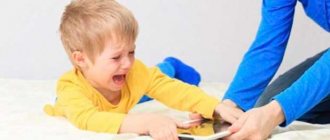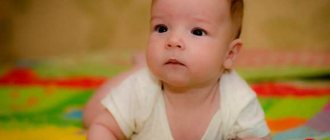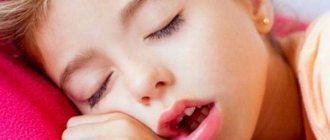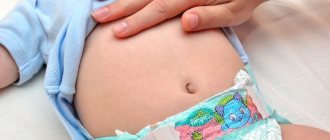The child rolls up and turns blue
Some parents experience a situation where their little child turns pale or blue while crying. This scares parents. What to do ? Let's figure it out together.
Affective-respiratory attacks
Children may experience temporary cessation of breathing or apnea. This can happen at the height of crying or under the influence of strong external or internal stimuli. The attack may be accompanied by loss of consciousness or convulsions. Such conditions in children are called affective-respiratory attacks.
They occur in approximately 5% of children aged 4 months and older. up to 5 years, with equal frequency in boys and girls. In approximately a quarter of children suffering from affective-respiratory attacks, similar conditions can be identified in childhood among relatives, i.e., a hereditary predisposition.
The cause of attacks is a violation of the regulatory mechanisms of the autonomic nervous system. Such attacks are accompanied by loss of consciousness in approximately 5% of children.
Affective-respiratory attacks are of the blue type and pale type.
- Seizures may first appear and be observed when a child is between 4 months and 5 years of age.
- Provoking factors are negative emotions, fear, discomfort. The child expresses his emotions by prolonged screaming and crying.
- At the peak of the cry, breathing stops (apnea), the child turns blue and may lose consciousness.
- The attack may be accompanied by clonic or clonic-tonic convulsions.
- The attacks are usually short.
- After an attack, the child may be lethargic and drowsy.
- Such attacks occur rarely during the child's life - 1-2 times.
- The cause of the attack is reflex cardiac arrest.
- An attack can be provoked by a painful stimulus.
- The child does not necessarily cry for a long time; pale skin and loss of consciousness develop quite quickly. The duration of the attack varies from a couple of seconds to hours.
- Once the attacks are over, children usually fall asleep. When they wake up, the children’s normal life activity is not disrupted.
- In case of heart disease (congenital defects, arrhythmias), such attacks can pose a danger to the child’s life.
- Parents should be aware of the child's tendency to hold their breath. To bring the child to his senses, you can sharply and quite intensely slap him on the buttocks, shake him, and splash cold water in his face.
- All this must be done carefully, calculating the force so as not to injure the child.
- If the attack was accompanied by loss of consciousness or convulsions, you need to call an ambulance.
- If the child did not lose consciousness, the attack was short-lived and was not accompanied by convulsions - you need to show him to the doctor as planned; this condition does not require calling an ambulance.
Children with blue-type affective-respiratory attacks usually do not require intensive care and usually do not require hospitalization unless the attack is accompanied by convulsions.
After an affective-respiratory attack, a child must be examined by a doctor, and subsequently carefully examined and taken under observation by a neurologist.
It is necessary to exclude other more serious diseases of the central nervous system (epilepsy, neuroinfections, brain tumors, etc.) and heart diseases (congenital heart defects and rhythm disturbances), which can also cause an attack of breath holding and loss of consciousness.
Child rolls up while crying Examination plan
- Examination by a pediatrician including measuring body temperature, counting the number of respirations, heartbeats, and carefully listening to heart sounds to identify murmurs and heart rhythm disturbances.
- General blood and urine tests, biochemical blood test.
- Examination by a neurologist. Electroencephalography (if the child’s age allows). On the electroencephalogram, after an affective-respiratory attack in children, no abnormalities are recorded. Ultrasound of the brain.
- According to indications, rheoencephalography, skull radiography, computed tomography or magnetic resonance imaging of the brain.
- Examination by a cardiologist. ECG.
Treatment
After the examination, the neurologist prescribes treatment. These could be drugs that improve cerebral circulation, nootropics, sedatives, vitamins. Anticonvulsant therapy (benzonal, finlepsin, depakine) may be prescribed.
The prognosis is favorable
With age, affective-respiratory attacks of the blue type disappear without a trace.
It's all about what to do if a child rolls up. Stay healthy!
Source: https://mamadoktor.ru/kak-pomoch-rebenku/rebenok-zakatyivaetsya.html
Reasons for the appearance of a blue tint
The nasolabial triangle is the area on the face limited by the mouth, nose and nasolabial folds. In newborns, this area turns blue when the level of oxygen in the blood decreases. In medicine, a similar phenomenon is called cyanosis, a decrease in the level of O2 in the blood to a level less than 95%. All causes of cyanosis can be divided into pathological and physiological.
Physiological reasons
This item includes indicators that are normal and do not imply any diagnosis. A blue nasolabial triangle in a baby may be a consequence of:
- Prolonged crying, at this time the duration of exhalation significantly exceeds the duration of inhalation, accordingly less oxygen enters the body.
- During breastfeeding, the baby makes significant efforts, the blood vessels dilate and may become noticeable.
- If a child spends some time at a high altitude relative to sea level, the level of oxygen in his blood decreases. The same thing happens to adults and does not entail danger.
- When hypothermia occurs, the nasolabial triangle is one of the first to turn blue. If you notice such changes after a bath or while changing clothes, just warm up your little one. Is the unhealthy tint gone? This means there is no need to worry, cyanosis is physiological.
Important! Blue discoloration, which is normal, goes away quickly. If you observe changes in skin color in other places, contact your pediatrician immediately.
Pathological factors
These causes include conditions that are unusual for the body and indicate diseases. They are divided into three groups:
- Conditions of central origin. In this case, the nasolabial area in infants often turns blue, accompanied by a sluggish sucking reflex. It is often observed after a difficult birth, with elevated blood pressure, head injuries, and underdevelopment of the vasomotor region of the brain.
- Pulmonary origin. Complemented by the general pallor of the child, blue color of the skin around the upper and lower eyelids. The cause may be any disease of the lungs and bronchial tubes, a foreign object entering the nasopharynx, or passive smoking.
- Cardiovascular origin. Cyanosis is one of the first symptoms of congenital heart defects. It manifests itself already in the first days after birth, while it is still impossible to hear murmurs in the heart rhythm.
As you can see, the causes of the disease can have completely different origins and require immediate or therapeutic treatment. But if there is still time before visiting the pediatrician, and your imagination draws the most terrible diagnoses in your head, you should pay attention to the child’s general condition and symptoms.
The child rolls up while crying and loses consciousness (turns blue)
How often does the average baby or toddler cry? There are no exact statistics, but experienced parents know that children can start crying up to 20 or even 30 times a day.
Normal crying is a normal reaction of a child to any irritation: hunger, fear, boredom or the inability to immediately get what he wants.
But what to do if a child rolls up while crying? Loss of consciousness, pallor or bluish skin can greatly frighten others, but, according to pediatricians, this condition is not always a pathology and does not require treatment.
Causes
Affective-respiratory attacks, due to which the child rolls up and turns blue, occur in healthy children aged 0 to 5 (less often years. Most often at the age of 6 months to 2-3 years.
years. Most often at the age of 6 months to 2-3 years.
The reasons for their occurrence are the peculiarities of metabolism in childhood and the immaturity of the nervous system.
If such attacks occur rarely - no more than once every few months, their duration does not exceed a few minutes, it is enough to tell a pediatrician or neurologist about them and more closely monitor the child’s health.
The cause of such attacks may be:
- Excessive fatigue of the child - children often become capricious when tired or hungry. They throw tantrums, throw up before bed, after active recreation or play.
- Strong negative emotions - fear, inattention from others, or prohibitions - can provoke an attack of rolling. This behavior is typical for excitable, emotional and spoiled children who do not know how to cope with emotions.
- Excessive mobility and activity of the child - hyperexcitability - also provokes such attacks.
- Sudden change in temperature - sometimes a child rolls up while crying and loses consciousness after bathing, or during bathing. This can be caused by a sudden change in temperature and constriction of blood vessels.
But sometimes the reason that a child rolls up when crying is pathology. Frequently recurring attacks should alert parents; it is necessary to exclude diseases such as:
- Epilepsy
- Brain injuries
- Infectious diseases of the brain
- Neoplasms of the nervous system
- Neurological diseases
- Respiratory system diseases
- Diseases of the cardiovascular system.
Only a specialist can determine why a child rolls up when crying. To do this, it is necessary to conduct a comprehensive examination, study blood tests, do an EEG and an ECG.
Symptoms
It is quite easy to determine that this is an affective respiratory attack - the child rolls up while crying and loses consciousness, his skin becomes pale, his lips turn blue, his eyes may roll back.
This condition occurs after hysterics, prolonged crying or screaming. The attack lasts from a few seconds to 1-3 minutes, after which the child comes to his senses, as if “waking up”. After an attack, the child becomes lethargic, may immediately fall asleep or begin to act up.
When is it necessary to consult a doctor?
The well-known pediatrician E. O. Komarovsky advises closely monitoring the child’s condition in order to understand when blueness of the skin around the mouth appears. Finding out the cause of cyanosis will help make the correct diagnosis and prescribe treatment, if necessary.
If you notice blueness of the nasolabial triangle, you should consult your doctor. The specialist will make an accurate diagnosis, rule out or confirm the presence of a pathological condition and tell you what to do so that the situation does not recur. The appearance of a symptom should not be ignored, as it may be a sign of a serious illness.
Mandatory consultation with a pediatrician is necessary if:
- the presence of an infectious disease of the upper or lower respiratory tract;
- impaired nasal breathing;
- long-term preservation of blueness;
- suspicion of a foreign object entering the respiratory system (it is prohibited to independently remove small particles with tongs and fingers);
- blueness of the tips of the fingers, hands and feet.
To reduce the risk of developing cyanosis, you must adhere to the following recommendations:
- monitor the air temperature and humidity in the room;
- bathe the baby in warm water;
- take a walk in the fresh air every day;
- maintain a daily routine;
- calm the child when crying;
- Do massage.
- Why does a child's nasolabial triangle turn blue?
- When you need to see a doctor urgently
- Diagnostics
- Treatment
Affective-respiratory attacks in children: how dangerous and what to do
Affective-respiratory attacks, this is the scientific name for a condition when a child, during a hysteria or crying, suddenly stops breathing, becomes silent and may even lose consciousness.
_
This phenomenon is not uncommon in children, and children who are emotional and easily excitable are more likely to get worked up.
The name consists of two words that reflect the essence of the attack - “affective” means the manifestation of violent, uncontrollable, usually negative, emotion. The word respiratory indicates the source of the problem – the respiratory system.
Affective-respiratory paroxysms are not a rare occurrence in children aged 7 months to 3 years.
Childhood neurosis: why the baby picks his nose and bites his nails
Due to the child’s underdeveloped respiratory and muscular systems, when he exhales too much, his lungs may be deprived of oxygen, and a spasm of the larynx will not allow him to take a breath in a timely manner. The likelihood of laryngeal spasm increases with a deficiency of calcium and vitamin D in the body, as well as with low hemoglobin in the child’s blood.
Since the need for calcium in a child is quite high - it is very actively consumed during the construction of bone and dental tissue, to one degree or another, deficiency of this mineral occurs quite often.
Doctors divide attacks according to the color of the skin changes into “pale” and “blue”:
- Pale paroxysm occurs after a child falls, a sudden blow, an injection, or severe fright, while the child may just start crying, but more often breathing stops even before screaming. The child cannot breathe, his mouth is open, but there is no crying. The heartbeat is delayed and the pulse is almost not palpable, the child’s skin turns pale, and in future life children prone to pale ARP are more likely to faint.
- A blue attack is usually a reaction to an emotional storm, dissatisfaction and anger that the child cannot cope with.
Such a reaction can develop when a child refuses to satisfy a momentary desire - to buy a toy, give daddy’s phone number, or a chocolate bar. Starting to cry, the child increases the degree of emotional stress; at one point he cannot breathe in air due to a spasm of the larynx, and the skin acquires a bluish tint. In this state, the child may lose consciousness, a loss of muscle tone is possible - he “goes limp”, or vice versa - he arches from their overexertion.
Burda Media
Despite the fact that the attack looks very scary, pediatric neurologists and pediatricians say that the child’s health, and especially his life, is not in danger. The spasm goes away on its own after a few seconds and the child, as a rule, feels quite normal, if you do not take into account that the reason that provoked the attack remains.
How to help your child
As a rule, the attack goes away within 20-30 seconds on its own - the spasm releases and the child takes a breath.
However, if you don’t have the strength to wait and are very scared, you can try to turn on your breathing by splashing cool water on your face, blowing lightly into your open mouth, or very lightly patting your cheek - this will help you take a reflexive breath.
There is no need to shake the child, hit, or generally make sudden movements; first of all, you need to take a deep breath and pull yourself together.
If a child becomes overwhelmed and begins to lose consciousness, the muscles relax and he may fall. Take your baby in your arms or lay him on his side to prevent falls and injury.
A “blue” attack, which always occurs against a background of hysteria and emotional excitement, can be prevented. If a child is screaming and is already on the verge, try to distract him in any way, knock him off the set program, surprise him - this may be enough to prevent him from stopping breathing.
m_vrn
However, you should not give in at this moment to the demand that caused the hysteria, in this way you can only strengthen the connection in his mind: request-refusal-hysteria-getting what you want.
It is important to remember that a child always responds better to interaction, or otherwise the command “forward”, rather than to a demand to stop any action. If you tell your baby, for example: “Let’s run together, let’s buy ice cream,” he is more likely to switch than if you shout to him “Calm down!!!”
It is necessary to teach a child to cope with attacks of anger and rage; for this, first of all, all family members need to learn how to do this.
How dangerous are affective-respiratory attacks?
Pediatricians and pediatric neurologists attribute these unpleasant manifestations to the physiological norm in the process of maturation of the nervous system and call them “age-related characteristics.” In most cases, the child simply “outgrows” them, with virtually no consequences.
It is important to make sure that the attacks are truly ARP and not a manifestation of more serious neurological problems; for this, consultation with a specialist is necessary.
Fotolia
You should contact a neurologist if:
- The attacks did not stop after 4-5 years of age or began before 6 months.
- The first attack occurred in a child over 3 years of age.
- Stopping breathing occurs more than 1-2 times a week, possibly due to frequent hysterics. In this case, you may need the help of a psychologist and correction of parental behavior.
- It is worth consulting a doctor if your child begins to have convulsions during a paroxysm.
When you need to see a doctor urgently
Here are some cases in which you should not delay seeking medical advice:
- if cyanosis began to appear after a prolonged cold. Perhaps this is how pneumonia manifests itself in a latent form, and for successful treatment of pneumonia it is very important to start antibiotic therapy as soon as possible;
- if the blueness appears after the child begins to have a strong tremor of the hands and chin, seemingly for no apparent reason. This is an indirect sign that a heart defect is preventing the body from functioning normally.
In the most dangerous cases, cyanosis is caused by mechanical suffocation. It is necessary to ensure that the child is not left alone with small objects that he can swallow. First aid in such a dangerous situation: take the child by the legs, with the head and body hanging down. You can shake the baby a little. A foreign body poses a threat to life, therefore, if you cannot remove it yourself, you should immediately call an ambulance.
The causes of cyanosis are determined by the doctor
What to do if a child rolls up while crying?
When a newborn cries, he is showing his dissatisfaction, fear, or other emotions. It’s another matter when a child rolls up while crying, thereby greatly frightening his parents. In medical terminology, this condition is called affective-respiratory paroxysm (ARP). The baby holds his breath when exiting, after which he cannot inhale normally for some time.
Parents must learn to distinguish a regular tantrum from an ARP. In the first case, the baby protests for a long time, cries and screams loudly. But during an attack of ARP, he becomes inactive, his skin turns blue, and the baby even loses consciousness.
Currently, there are two main types of ARP:
- Pale attacks. Usually this phenomenon occurs as a result of severe pain or fear. For example, a pale attack may appear after an injection. In this case, the pulse completely disappears for some time and the heartbeat is delayed. The child loses consciousness. In the future, such children often experience fainting.
- Blue attacks. Appear as a result of the baby’s anger or dissatisfaction. The child begins to scream, but when he inhales, his breathing stops, after which he becomes silent and turns blue.
As a rule, both attacks occur quickly and pass within 30 seconds. But sometimes they are protracted. The baby may become soft or, on the contrary, muscle spasms appear, causing the child to arch in the shape of an arc.
Sooner or later, almost every mother has a question: “Why does the child roll up when crying?” This phenomenon usually appears in the first years of life, and completely disappears by about eight years.
Some parents mistakenly believe that the baby is faking a seizure, thereby wanting to control the adults.
However, ARP has a reflex nature, which is why the baby breaks down into a crying fit, and in some cases even loses consciousness.
Breathing stops for half a minute or even a minute. As a result, the color of the skin changes and the child turns blue. Most often, ARP appears in irritable, aggressive and overly active children.
In addition, the following reasons provoke an attack:
- Frequent stressful situations, attacks of anger. Moreover, even ordinary discomfort - fatigue or lack of food - can stimulate ARP.
- Often the reason why a child rolls up while crying is the parents. You cannot overprotect your baby and give him everything he wants. After all, if you then deny him something, he will react violently, which will cause another attack.
In any case, you need to consult a doctor after the first attack of ARP while crying. The neurologist will conduct a diagnosis, after which he will prescribe treatment. You should not delay visiting a specialist, as over time the attacks may become epileptic.
If attacks of ARP are frequent and long-lasting, the child will:
- rolls up while crying and loses consciousness;
- convulsions begin;
- he becomes pale;
- lips turn blue.
As a result of the spasms, the baby's muscles become very tense, causing his small torso to arch.
In more rare cases, cramps are accompanied by involuntary urination. As a rule, breathing is restored immediately after the cramps pass.
What to do when a child rolls up while crying?
- The main thing is not to panic. It is urgent to restore the baby's breathing. To do this, just pat him on the cheeks, sprinkle him with cold water, and direct a stream of fresh air into his face. Under no circumstances should you shake your child or hit him in the face too hard.
- At the age of 5 years, children's bones are still very fragile, so intense exposure to them can lead to fractures and dislocations. If the attacks are not severe, then tickling helps restore breathing.
- Sometimes symptoms of ARP resemble epilepsy. In this case, the attacks last a long time - more than one minute, and convulsions appear. In this case, the baby must be placed on its side to avoid suffocation. Sometimes it is necessary to hold the legs and arms so that the baby does not injure himself.
First aid measures should be started immediately after the symptoms of an attack appear. After the child’s breathing is restored, the baby needs to be distracted by offering him a bright toy. To calm the baby, you need to put him to the chest and hug him.
If a child rolls up while crying, it is necessary to urgently begin treatment:
- Parents turn to a neurologist, who, before conducting diagnostic tests, asks the parents a number of questions: why the attack occurred, how it went, what preceded it. In addition, the doctor clarifies what symptoms accompanied the attack (blueness, urination, chest pain, rapid heartbeat).
- After this, the doctor prescribes an examination. An ECG, ultrasound and EEG of the brain are performed, urine and blood tests are taken. Only after this the neurologist prescribes treatment. As a rule, children with attacks of ARP should be under medical care until they are 5-7 years old.
- Treatment includes two directions - medicinal and non-medicinal. If the child is over 3 years old, the doctor recommends making an appointment with a psychologist. In addition, the psychologist will adjust the methods of raising the child so that the atmosphere in the family is calm and friendly. The specialist offers parents a number of games and exercises that help suppress outbursts of anger.
- During play activities, the child forgets about all his problems, he becomes calmer. Non-drug treatment is leading. And if you arrange the environment correctly, your baby may not even need to take medications.
- In more complex cases, the doctor prescribes medications to treat neuropathy and increased excitability of the child. All medications are prescribed exclusively by a neurologist. You should not buy tablets on the advice of friends or pharmacists.
If a child rolled while crying and turned blue once, this phenomenon may repeat.
To prevent this from happening, you must adhere to certain measures:
- Parents must teach their children to control their emotions. In addition, adults should avoid situations that can cause a violent response from the baby’s body. It is not recommended to expose children to long trips or walks, during which they become overtired.
- Some kids don't like to rush. They are slowly getting dressed for kindergarten. You should not push them, as this may provoke anger. It’s better to wake up your baby 5 minutes earlier so that you can get ready without rushing. If an attack has already begun, you should not shout at the child, as this will frighten him even more. It is necessary to approach this issue tactfully and reassure the baby. If the child is an adult, after an attack he needs to be explained that he must breathe correctly and remain calm in any situation.
- It is important that both parents participate in the upbringing process.
- If seizures occur in a “home” child, it is recommended to enroll him in kindergarten. Sometimes the opposite happens: the child fails because he does not want to go to preschool. In this case, it is better to leave him at home for a while, and you can take him back to kindergarten only after preparation.
The materials posted on this page are informational in nature and intended for educational purposes. Site visitors should not use them as medical advice. Determining the diagnosis and choosing a treatment method remains the exclusive prerogative of your attending physician.
Source: https://allergology.ru/zdorove/rebenok-zakatyvaetsya-pri-plache
What to look for
Analysis of the baby’s condition is an integral part of the life of a young mother, because the baby’s health, as well as her own peace of mind, often depends on her attentiveness. But don’t rush to panic if the area around your little one’s mouth turns blue, answer the following questions:
- Was there a delay in the development of the baby, how did the birth proceed?
- Have any problems in the functioning of the heart or vascular system been previously detected?
- Is the usual breathing rhythm maintained when the color of the nasolabial triangle changes, and is there a cough?
- What color are the remaining areas of the skin?
- What is the baby’s general condition? Is there any lethargy or constant drowsiness?
If all the questions do not cause you concern, then you can observe the child. If at least one of the points occurs, then you need to consult a pediatrician.
A child rolls up while crying - what to do, how to calm him down?
How frightened parents are when their child collapses while crying! And no wonder. The baby suddenly stops breathing and faints... It’s simply impossible not to panic here.
The nature of the occurrence of affective-respiratory attacks
As is already clear from the name itself, this state is associated with the highest nervous excitement, and in a negative direction. The attack usually occurs when the child cries a lot.
The baby's sobs at the moment of the strongest emotional experience are accompanied by a sharp spasm of the muscles of the larynx after a deep exhalation. By holding your breath, oxygen supply to the brain stops. ARP resembles laryngospasm combined with fainting.
Actually, loss of consciousness is a protective reaction of the body itself to a lack of oxygen. After all, when a person faints, oxygen consumption decreases significantly. And until the baby is able to breathe, he will not get out of this unconscious state.
Usually, spasms of the laryngeal muscles are relieved without outside intervention. Since oxygen does not enter the body due to holding the breath, carbon dioxide accumulates in it. It is the state of hypercapnia that affects the brain, which sends a signal to reflexively relieve spasm of the laryngeal muscles. The kid sighs, and consciousness returns to him.
Doctors have noticed that children with metabolic peculiarities are more predisposed to such attacks. For example, a child who has a calcium deficiency has seizures more often than one who is normal in this regard. After all, it is precisely the lack of calcium that contributes to laryngeal spasms.
Most doctors agree that the occurrence of attacks of this kind is due to genetic predisposition, that is, so-called heredity.
Separately, it should be emphasized that children who are nervous, hyperexcitable, and overly impressionable begin to cry many times more often than calm, apathetic or phlegmatic children. Children who are spoiled and hysterical should be included in the category of particularly susceptible to ARP.
However, even among balanced, well-mannered children there are those who, at least once, rolled up while crying.
Is it a disease when a baby stops breathing while crying?
As statistical data show, affective-respiratory attacks in children are not at all so rare. A quarter of all children, including healthy ones, have had this happen at least once.
It has been noticed that usually the situation when a child breaks down crying while experiencing strong emotions most often occurs once. This can happen again in only 5% of children. Therefore, it is impossible to say with one hundred percent certainty that if a child rolls up while crying, then he is susceptible to some kind of disease.
It’s another matter if this is not an isolated case at all. Therefore, parents whose child regularly collapses when crying should sound the alarm.
If this happened only once (or for the first time), then there is no reason to worry too much.
But, undoubtedly, the alarm should be sounded in cases where holding one’s breath during strong sobs occurs frequently, more than once a week or, even more alarming, several times a day.
You should especially worry if a crying boy or girl begins to cry over the age of 6 years. After all, usually by this time attacks of this kind do not occur.
Why can recurring attacks of ARP occur after 6 years?
This question is quite difficult to answer. Most likely, the child is seriously ill. And only seeing a doctor will help you make a correct diagnosis.
Cardiogenic diseases, that is, associated with disturbances in the rhythm of the heart muscle, can cause fainting with blue lips. And although such loss of consciousness is not directly related to crying and can occur without sobbing, it is quite likely that they occur at a time of high nervous tension.
Many neurological diseases have similar symptoms. These are Arnold-Chiari malformation, vamilial dysautonomia, Rett syndrome. This also includes attacks with loss of consciousness in children with blood pathologies (iron deficiency, erythroblastopenia).
And it’s worth remembering epilepsy. This disease is also accompanied by seizures. An experienced doctor can easily distinguish affective-respiratory seizures in children from epilepsy. But every parent should see the difference so as not to miss the symptoms of a serious illness.
Do affective-respiratory attacks occur in newborns?
Typically, a situation where a child suddenly rolls over while crying and stops breathing is first observed at six months of age.
After all, even the name of the state, as mentioned above, indicates that the baby at this moment is in a state of passion - the highest nervous excitement.
Younger children are not yet ready to experience strong emotions, since their consciousness is not yet sufficiently developed.
If the newborn cries so much that he rolls, then you definitely need to see a doctor. Strong emotions such as anger, despair, resentment are inaccessible to a child of this age.
The crying of an infant signals physical discomfort, hunger or pain. And if a newborn cries non-stop, with loss of breath and for no apparent reason, most likely something is very painful for him.
Perhaps the baby is seriously ill.
What is the harm of stopping breathing while crying?
It is clear that if a child (2 years old) rolls up when crying, but this does not happen often, there is no point in parents contacting doctors about this.
Of course, apnea - episodic holding of breath - does not benefit the body, since the brain is deprived of oxygen at this moment.
But the short-term loss of consciousness that accompanies this process somewhat reduces the harm from this. After all, in an unconscious state, the brain requires a minimum of oxygen.
However, you need to be careful about the baby’s condition at this time. If the attack does not end after a minute or occurs too often, several times a week, you should consult a doctor at the clinic. Parents should also be concerned about the change in the baby’s behavior at this moment.
Two types of ARP attack
There are two states of a child who collapses while crying. If the baby experiences severe pain, from which he begins to cry, then usually during a short breath-hold he becomes very pale. A sharp slowdown in heart rate is observed during this period. Sometimes it can become thread-like or disappear completely for a short time.
If a child turns blue when crying, then such an attack usually occurs due to emotional affect. During it, you can notice a pronounced cyanosis of the child’s skin, loss of consciousness, and holding his breath. During a prolonged attack, a crying boy or girl seems to go limp, and sometimes, on the contrary, begins to arch.
Can a child voluntarily provoke ARP?
Most doctors say no. They are sure that breathing stops reflexively, regardless of the child’s wishes.
However, despite such statements by authoritative doctors, those people who “rolled up” while crying in childhood recall that they sometimes artificially induced fainting. This happened during times of strong emotional excitement, when a sobbing child suddenly noticed that adults were not reacting to his actions at all.
Remembering how everyone fussed around him after another attack, worried and worried, the kid decides to punish the adults. When he sobs, he deliberately exhales more air and holds his breath for a short time.
In 9 cases out of 10, this works - the child, through his own efforts, deprives his brain of oxygen and loses consciousness. This provoked attack is no different from reflex ones. It occurs with the same symptoms.
Another variant of simulation is possible, when children, observing the behavior of their peers, try to act out a seizure. Such cases also occur. But attentive adults will feel that the baby is “playing,” because in this case the color of the face and lips remains normal, and breathing does not stop.
How should adults behave during an attack?
All assurances from doctors that ARP is not some serious disease, and that the baby will not lose consciousness while crying, is an empty phrase for loving parents. Naturally, they don’t want to sit quietly and watch their baby turn blue and fall flat on the floor. But few people know what to do when a child rolls up.
The most important thing at this moment is to help the baby restore his breathing. To do this, you can lightly pat him on the cheeks, massage the ears, neck and chest area. Experts advise that when ARP occurs, blow into the child’s face or wave a newspaper at him or direct a fan jet.
You can quickly help restore breathing by splashing some water on your baby. It is also good to wipe your face with a towel soaked in cold water. Some people use tickling to quickly bring the child to his senses.
Ammonia is usually not used in this case. The smell will not help speed up the process of breathing restoration, but at the moment the baby emerges from an unconscious state it can frighten.
This is especially undesirable if ARP occurs in children under 3 years of age. After all, most of them do not understand what is happening to them.
And often they don’t even remember what preceded the fainting, what were the reasons for crying.
After the child has come to his senses, he feels very tired and really wants to sleep. You shouldn't interfere with this. After deep restorative sleep, which can last up to 2-3 hours, children usually feel normal.











